Even if you don't have any equipment, you can still get a good workout, make progress and gain muscle.
To gain lean mass without going to the gym, all you need to do is apply a few simple rules of physics and nutrition to get the most out of every move.
With or without weights: which form of bodybuilding is the most effective according to science?
A study published in 2018 on 23 men followed for 4 weeks compared the increase in fiber thickness and muscle strength from push-up and bench press exercises.
The aim of this study was to determine whether bodyweight training(calisthenics) was comparable to traditional bench press training for increasing strength and muscle mass.
The study recorded greater improvement in the test group who did bodyweight exercises (they were able to do more push-ups at the end than the other test group). On the other hand, no significant difference was found in the increase in muscle mass between the two groups.
In contrast, a study published in 2010 by 11 researchers found that low-load, high-volume resistance training (e.g. bodyweight exercises with many repetitions) is actually more effective for muscle building than high-load, low-volume resistance training (e.g. weightlifting).
These results suggest that bodyweight exercises are more effective in inducing acute muscle anabolism.
What's more, bodyweight exercises induce all three muscle-building mechanisms - mechanical tension, muscle damage and metabolic stress.
What's more, a 2017 study concludes that calisthenics is a feasible and effective training solution for improving posture, strength and body composition without the need for extensive training equipment.
The use of bodyweight as a source of "resistance" is therefore an excellent substitute or complement to free weights such as dumbbells or barbells. Depending on your sport and objectives, weight training without equipment can replace all or part of dumbbell exercises.
However, just as in the gym, where you'll gradually increase the load, building muscle through bodyweight training isn't just about performing the exercises. It's also about gradually increasing the tension applied to the muscles.
In short, as with dumbbells, you'll need to gradually increase the intensity and difficulty of each muscle-building exercise to challenge your muscles over time.
This prevents your muscle groups from becoming too accustomed to the training routine. By continually pushing your body's muscles to do more, you provide them with the perfect stimulus to overcome the plateau and achieve greater muscle growth.
Is calisthenics effective for weight loss?
Another study analyzed the effects of calisthenics on obese children.
They performed six different bodyweight exercises three times a week, and the study showed that within six months, the average child went from 45% to 25% overweight.
With or without weights, both can be used as a form of strength training, to increase endurance and improve bone health, but the most common advantage of weight training without equipment compared is the flexibility it offers. Let's take a closer look.
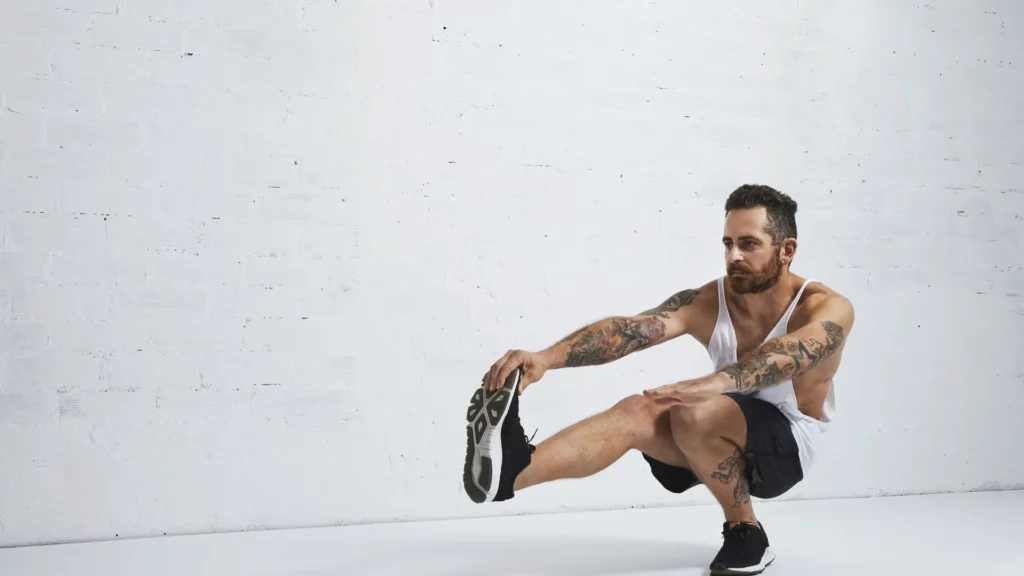
The benefits of weight training without equipment
Strength training without equipment, also known as calisthenics, is an effective way of strengthening and toning the body.
There are disadvantages to this form of training, but also many advantages, such as flexibility, economy and simplicity.
Flexibility: train when and where you want
One of the most important advantages of equipment-free weight training is the flexibility it offers. With only your own body weight as equipment, you can train anywhere, anytime.
This means you can work out at home, while traveling, outdoors or even in the office, without having to worry about finding a gym or buying expensive machines.
A simple way to save money
Another advantage of equipment-free weight training is that it doesn't require investment in expensive equipment.
Using only your own body weight, you can perform effective exercises to strengthen and tone your body, without having to spend money on expensive machines.
It also means you can save money on gym memberships and equipment costs.
Simplicity: a form of training accessible to all
You don't need to know how to use complicated machines or follow complex training programs.
Basic exercises such as push-ups, squats and sit-ups can be learned quickly and performed at home. This means that even beginners can start building muscle quickly and easily, without the need for technical knowledge or professional advice.
What are the main bodybuilding exercises without equipment?
There are many equipment-free bodybuilding exercises that can target different parts of the body. In this section, we'll take a look at the main equipment-free bodybuilding exercises, their benefits and how to perform them correctly.
The pumps
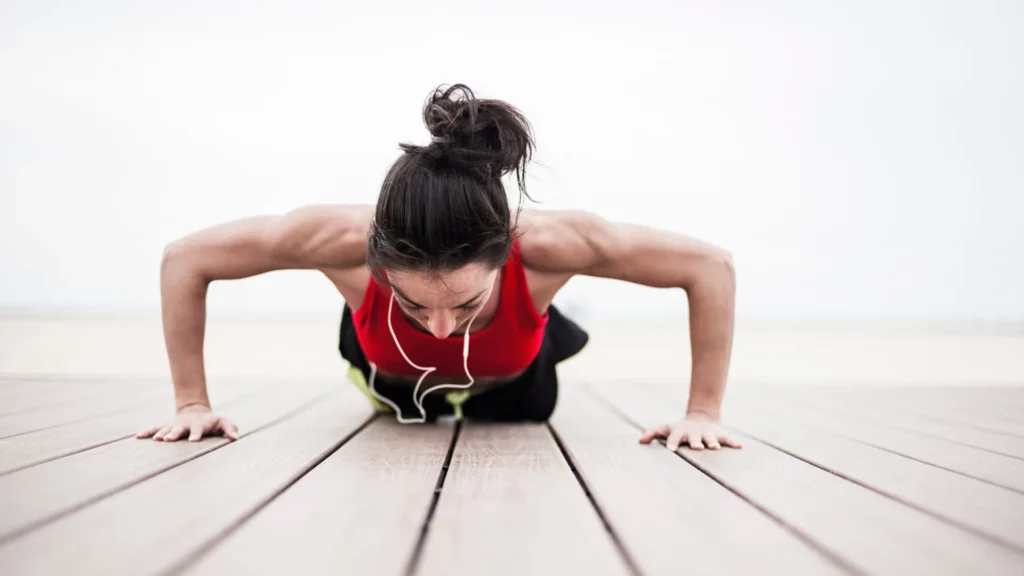
Push-ups are a basic exercise for strengthening pectorals, triceps and shoulders.
It consists of getting into a plank position, with hands shoulder-width apart, and bending the elbows to lower the torso towards the ground, then raising it again.
- Get down on all fours on the floor, placing your hands slightly wider than your shoulders and keeping your elbows slightly bent.
- Extend your legs backwards so that you're balancing on your hands and toes, with your feet hip-width apart.
- Contract your abdominal muscles and tighten your core, bringing your navel towards your spine.
- Inhale as you slowly bend your elbows and lower yourself towards the floor, until your elbows form a 90-degree angle.
- Exhale, contracting your chest muscles and pushing upwards with your hands, to return to the starting position.
- Keep your core tight throughout the exercise. Also keep your body in a straight line from head to toe, without slouching in the middle or arching your back.
It's important to respect this form to avoid injury and maximize exercise efficiency. Don't lock your elbows, and keep them slightly bent.
It's also important to keep your core sheathed and supported. It's best to start with assisted push-ups or kneeling and progress gradually to avoid injury.
Dips
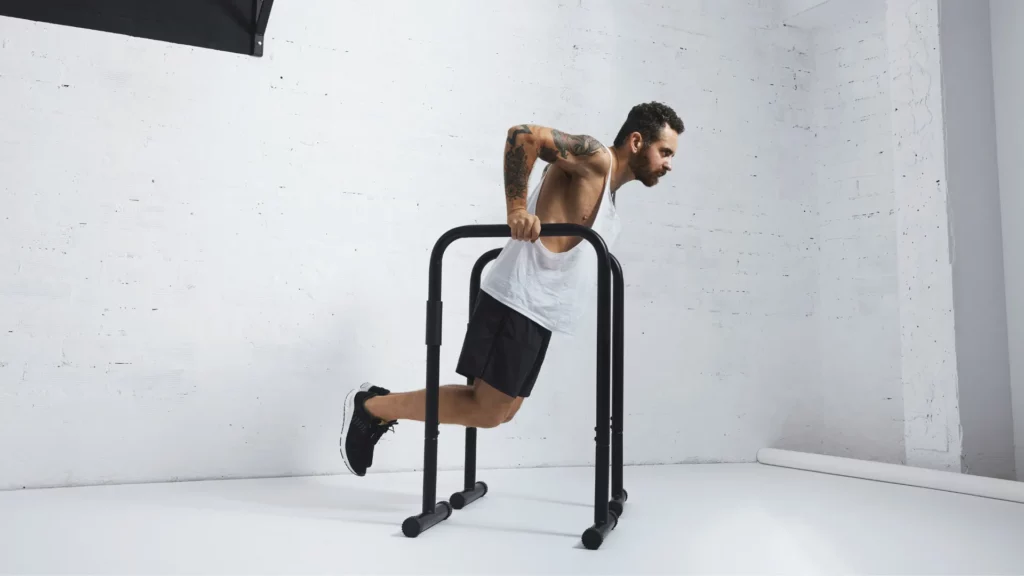
Dips are an exercise for strengthening the triceps and shoulders. It involves getting into a plank position, with your hands resting on a bench or bar, and bending your elbows to lower your torso towards the ground, then raising it again.
To perform dips effectively and without pain, follow these steps:
- Grab the parallel bars and jump up, stretching your arms.
- Lower your body by bending your arms while leaning slightly forward.
- Lower until your shoulders are under your elbows.
- Lift your body by straightening your arms.
- Lock your elbows at the top.
Dips are a compound exercise that uses body weight to strengthen the muscles of the chest, shoulders, back and arms.
It's important to maintain good form to avoid pain and maximize exercise efficiency. Take care to keep your shoulders back and down, don't go too low, use fixed parallel bars and avoid dips on rings to protect your wrists.
Squats

Squats are an exercise for strengthening the thighs and buttocks. It involves standing with your feet hip-width apart, bending forward with your back straight, then pushing up on your heels. Find out more tips on this subject in our article on whey for glutes.
Squats are a functional exercise that benefits the health of your joints and muscles, as well as your posture.
To perform squats, it's important to maintain good posture: feet hip- and shoulder-width apart, toes turned out slightly (between 5 and 15 degrees), spine relaxed, shoulders back and down, chest open and high, heels down and planted throughout the movement. You can place your hands in front of your chest for balance.
To perform the movement, send the hips backwards, bend the knees to descend as low as possible, lifting the chest in a controlled movement, keeping the lower back neutral.
Press down on your heels to lift yourself up and return to the starting position. It's important to respect form to avoid injury and maximize exercise efficiency.
Common mistakes to avoid are
- heels lifting,
- the back that bends,
- falling chest,
- feet that are too wide or too narrow,
- knees that sink inwards,
- too fast an execution speed,
- the lack of depth in the movement.
Abdominal exercises

There are many exercises for strengthening the abdominal muscles, such as crunches, leg raises and twists. These exercises target the muscles of the abdomen to strengthen and tone them.
To make crunches :
- Lie on your back with your feet hip-width apart on the floor.
- Bend your knees and place your arms crossed over your chest.
- Contract your abdominal muscles and inhale, then exhale as you lift your upper body, keeping your head and neck relaxed.
- Inhale and return to the starting position.
It is important to observe a few safety instructions during this exercise:
- Use your abdominal muscles to lift your upper body, avoiding pulling with your head or neck to avoid injury.
- Use slow, controlled movements to target the right muscles and avoid sudden movements.
- It's best to start with the hands crossed over the chest to master the correct form before using the hands-behind-the-head technique to avoid straining the neck.
The board
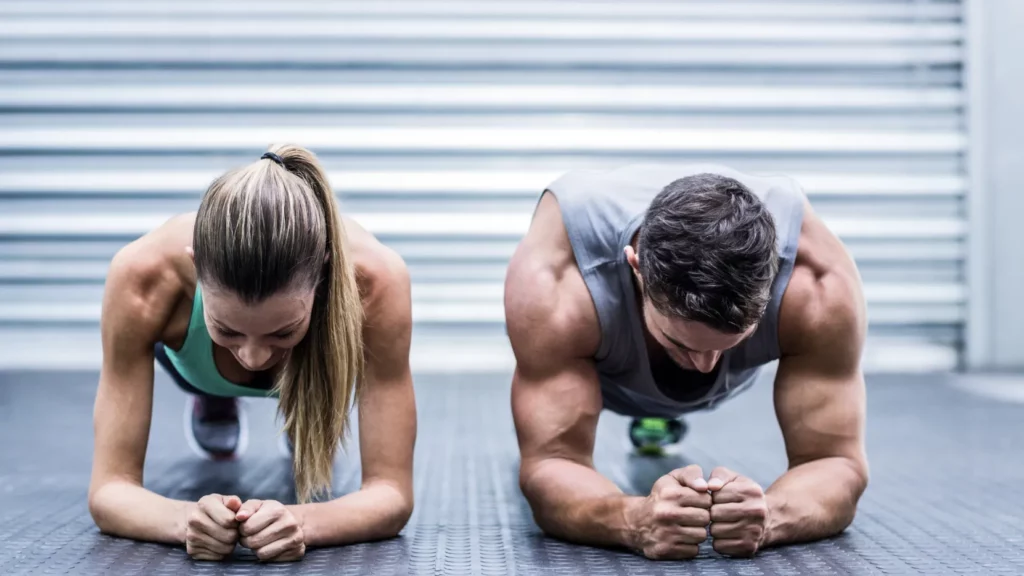
The plank is an exercise for strengthening the abdominal and lumbar muscles. It involves getting into a plank position, with hands and elbows resting on the floor, and holding this position for a certain length of time.
If you don't yet have the strength to do a normal plank, you can prepare for this by doing a plank with your knees bent. If you can hold a plank for more than two minutes without any problems, you can move on to these more difficult variations.
- Lift one leg in the air. By simply lifting one leg in the air, you're asking your core to fight your body's natural urge to rotate.
- Raise one arm in the air. Again, your body will want to fall to one side. Don't let it.
- Use a medicine ball. Place your forearms on the ball and stabilize your body to prevent the ball from slipping out from under you.
Pull-ups
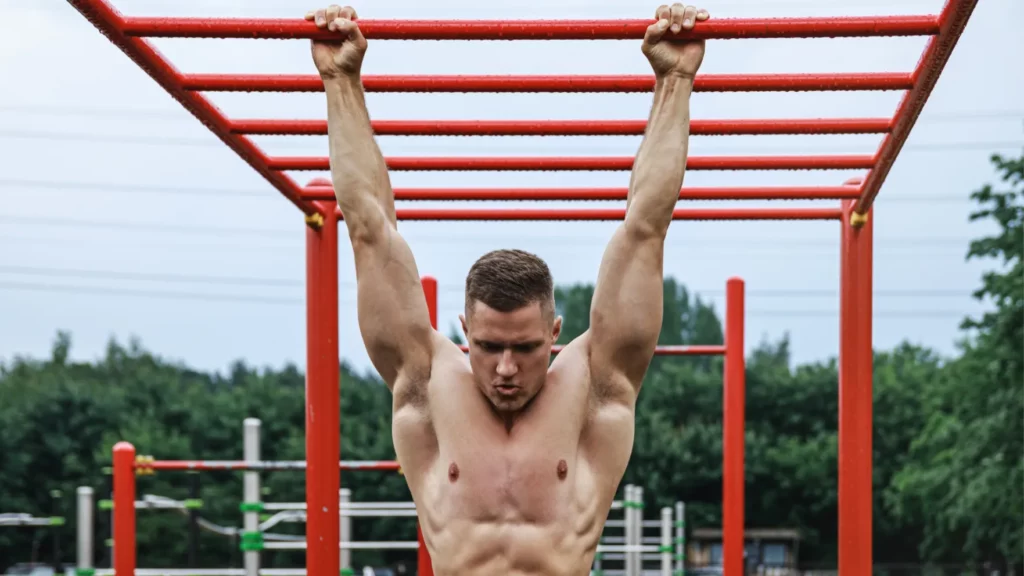
Pull-ups are an exercise for strengthening the back. It involves hanging from a barbell, hands shoulder-width apart, and lifting your body, contracting your back muscles.
Pull-ups are considered one of the most comprehensive exercises for strengthening the back. Pull-ups primarily target the shoulder and arm muscles, in addition to the back muscles.
They help develop good posture and resistance to injury. Pull-ups can be performed at different levels of difficulty using a variety of grips, such as a pronated grip (palm backwards) or a supinated grip (palm forwards), or using ballast or elastic bands to facilitate or increase the difficulty of the exercise.
It's important to warm up before doing pull-ups to avoid injury. It's also advisable to start with assisted pull-ups and progress gradually to avoid injury.
Jumping jack

Jumping jacks are a cardio exercise that strengthens the legs and abdominals, and involves jumping with the legs apart and the arms raised above the head, then bringing them back to the starting position.
This exercise can be done anywhere and anytime, it just requires a little space to jump.
How to maximize muscle gain without equipment?
Whether with or without weights, good nutrition and adequate rest will make up 50% of your progress and muscle mass gain. Without proper nutrition for muscle gain, you'll lose most of your efforts.
In short, it will be difficult to achieve your goals if you don't fuel your body with the right foods.
When it comes to building muscle or losing fat, you need to consume a certain amount of each macronutrient to achieve your goals (carbohydrates, proteins and fats).
For example, to build muscle, you need to consume a large amount of protein as it contains amino acids, which are used for muscle growth.
Here is a summary table of protein requirements for information purposes.
| Gender | Physical activity | Recommended protein intake (g/kg/day) | Target weight gain |
|---|---|---|---|
| Men | Sedentary | 0.8 - 1 g/kg/day | 1.3 - 1.5 g/kg/day |
| Men | Moderate | 1 - 1.2 g/kg/day | 1.5 - 1.7 g/kg/day |
| Men | Intense | 1.2 - 1.7 g/kg/day | 1.7 - 2 g/kg/day |
| Woman | Sedentary | 0.8 - 1 g/kg/day | 1.2 - 1.4 g/kg/day |
| Woman | Moderate | 1 - 1.2 g/kg/day | 1.4 - 1.6 g/kg/day |
| Woman | Intense | 1.2 - 1.5 g/kg/day | 1.6 - 1.8 g/kg/day |
Note: These recommendations are general and may vary according to individual needs, so it's best to consult a dietician for a personalized food plan.
So, if you only eat sweet potatoes (which are made up of carbohydrates) to cover all the calories you need, you won't be able to build muscle because you're missing the essential building blocks of protein to help repair and maintain muscle tissue.
Conversely, if you consume large quantities of foods containing high levels of fats and carbohydrates to meet your protein requirements, you risk putting on more weight than you need, as your total calorie intake will be far greater than your requirements.
When it comes to the best diet to maximize the effectiveness of your sessions, there's no magic formula but rather some basic suggestions that you should follow. Regarding the timing of protein intake for mass gain, for example, try not to consume it before eating so as not to spoil your appetite, and if possible after the end of your session to take advantage of a possible anabolic window.
The role of lipids in progress
Lipids play an important role in muscle gains, as they are essential for maintaining healthy muscle cells and for proper recovery after training. Lipids are also important for the production of anabolic hormones, such as testosterone, which are necessary for muscle growth.
Omega-3 fatty acids, in particular, have been shown to improve muscle recovery and muscle growth.
Lipids are also necessary for the transport of fat-soluble vitamins such as vitamins D, E and K, which play fundamental roles in muscle metabolism.
It's important to note that not all types of fat are equal when it comes to building muscle and your overall health. Saturated and trans fats are considered unhealthy and should be limited.
Unsaturated fats, such as omega-3 and omega-6 fatty acids, are considered beneficial to health and should be incorporated into the diet.
How important are carbohydrates?
Why take carbohydrates with your whey protein? Carbohydrates also play a crucial role in muscle building, as they are the main source of energy for muscles during training.
Carbohydrates are stored in the muscles in the form of glycogen, which is used as an energy source during exercise, and its reserves can be depleted.
Muscles need a good supply of carbohydrates to function efficiently and recover from training.
Carbohydrates also have an impact on insulin levels, a hormone that plays a key role in regulating muscle growth. Insulin is secreted when blood glucose levels rise, and stimulates the entry of glucose and amino acids into muscle cells, helping to synthesize protein and rebuild muscle fibers.
Simple carbohydrates, such as sugar, can cause significant fluctuations in blood glucose and insulin levels. Complex carbohydrates, such as vegetables, fruit, whole grains and legumes, provide quality carbohydrates, as well as an important source of fiber, vitamins and minerals.
What role do proteins play in training?
Protein, made up of amino acids(BCAAs), is the cornerstone of your progress. Without it, no progress.
The amino acids they contain are used to build, repair and maintain muscle tissue that undergoes micro-trauma during exercise.
Muscles need sufficient protein intake to grow and repair after training, which is necessary to increase muscle mass.
Now let's take a look at how to choose your protein soure.
Animal proteins, such as meat, fish, eggs and milk, have a higher biological value and contain all the essential amino acids needed for muscle growth.
Plant proteins, such as legumes, seeds and nuts, are also a source of quality protein, but can be less effective as they don't contain all the essential amino acids.
With high training volumes, it can sometimes be complex to reach your daily protein intake targets for mass gain.
Supplementation is therefore an interesting option if properly supervised. You can take your whey in the classic way in a shaker, or try out your own protein shaker recipes.
Here are a few rules to help you.
- Choose products with no additives or sweeteners. The shorter the list of ingredients, the better.
- Don't be fooled by the marketing names (hydrolate, isolate, pure...) Classic whey protein is the best protein powder option for 80% of all forms of training.
- Choose a product made in France. Traces of doping products have already been found in products manufactured in Europe.
- Don't bake your whey if it contains sucralose. Whey cookies are delicious, but this additive turns sucralose into toxic compounds when heated.
ProtéAlpes products tick all the boxes, so don't hesitate to give them a try!
Conclusion
It's perfectly possible to build muscle without equipment. There are many bodyweight exercises that appear to be at least as effective as dumbbell training. However, the exertion phase is only part of the picture.
When you do strength training without equipment, you put your body under high levels of tension so that it can overcome the movements in training. For example, performing perfect repetitions while doing pull-ups, dips, push-ups and squats.
This means you need to monitor your hydration, sleep and diet.
With regard to possible mass-building supplements, proteins in particular help to repair and build lean muscle after exercise. This increases muscle mass and strength, which is essential for progress.
To continue reading...
Nutrition is a complex subject, and this article has already gone far enough. To delve deeper into this subject, we recommend the following articles:
Which whey should you choose to start with?
Which is the best whey for mass gain?
Which whey should you take to dry out?
Should youtake whey on rest days?
Does whey make you put on weight?
How long does mass gain last?
How many whey shakers per day?













